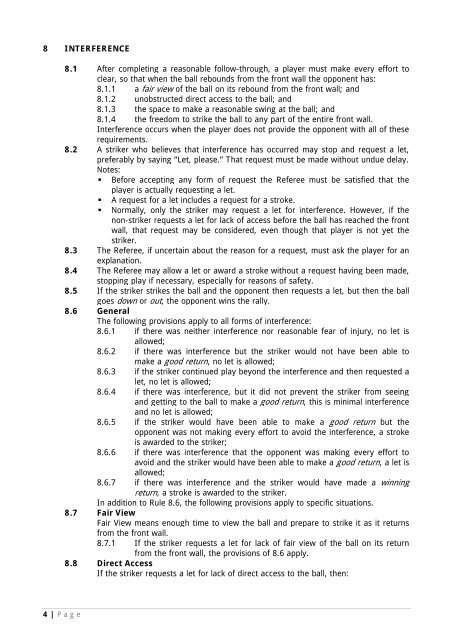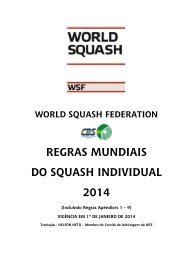Regras Squash-2014-V2014-03
You also want an ePaper? Increase the reach of your titles
YUMPU automatically turns print PDFs into web optimized ePapers that Google loves.
8 INTERFERENCE<br />
8.1 After completing a reasonable follow-through, a player must make every effort to<br />
clear, so that when the ball rebounds from the front wall the opponent has:<br />
8.1.1 a fair view of the ball on its rebound from the front wall; and<br />
8.1.2 unobstructed direct access to the ball; and<br />
8.1.3 the space to make a reasonable swing at the ball; and<br />
8.1.4 the freedom to strike the ball to any part of the entire front wall.<br />
Interference occurs when the player does not provide the opponent with all of these<br />
requirements.<br />
8.2 A striker who believes that interference has occurred may stop and request a let,<br />
preferably by saying “Let, please.” That request must be made without undue delay.<br />
Notes:<br />
• Before accepting any form of request the Referee must be satisfied that the<br />
player is actually requesting a let.<br />
• A request for a let includes a request for a stroke.<br />
• Normally, only the striker may request a let for interference. However, if the<br />
non-striker requests a let for lack of access before the ball has reached the front<br />
wall, that request may be considered, even though that player is not yet the<br />
striker.<br />
8.3 The Referee, if uncertain about the reason for a request, must ask the player for an<br />
explanation.<br />
8.4 The Referee may allow a let or award a stroke without a request having been made,<br />
stopping play if necessary, especially for reasons of safety.<br />
8.5 If the striker strikes the ball and the opponent then requests a let, but then the ball<br />
goes down or out, the opponent wins the rally.<br />
8.6 General<br />
The following provisions apply to all forms of interference:<br />
8.6.1 if there was neither interference nor reasonable fear of injury, no let is<br />
allowed;<br />
8.6.2 if there was interference but the striker would not have been able to<br />
make a good return, no let is allowed;<br />
8.6.3 if the striker continued play beyond the interference and then requested a<br />
let, no let is allowed;<br />
8.6.4 if there was interference, but it did not prevent the striker from seeing<br />
and getting to the ball to make a good return, this is minimal interference<br />
and no let is allowed;<br />
8.6.5 if the striker would have been able to make a good return but the<br />
opponent was not making every effort to avoid the interference, a stroke<br />
is awarded to the striker;<br />
8.6.6 if there was interference that the opponent was making every effort to<br />
avoid and the striker would have been able to make a good return, a let is<br />
allowed;<br />
8.6.7 if there was interference and the striker would have made a winning<br />
return, a stroke is awarded to the striker.<br />
In addition to Rule 8.6, the following provisions apply to specific situations.<br />
8.7 Fair View<br />
Fair View means enough time to view the ball and prepare to strike it as it returns<br />
from the front wall.<br />
8.7.1 If the striker requests a let for lack of fair view of the ball on its return<br />
from the front wall, the provisions of 8.6 apply.<br />
8.8 Direct Access<br />
If the striker requests a let for lack of direct access to the ball, then:<br />
4 | P age



